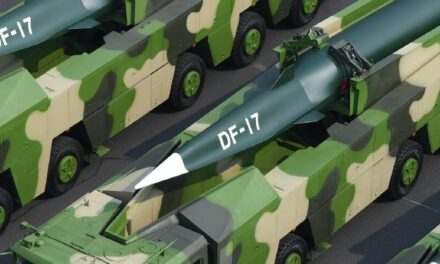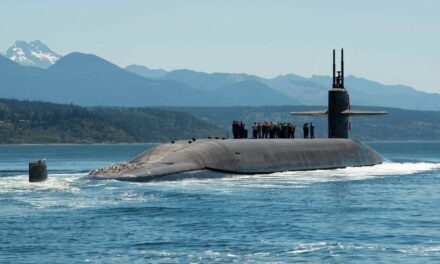We support our Publishers and Content Creators. You can view this story on their website by CLICKING HERE.
Key Points: The USS Parche, a modified Sturgeon-class nuclear-powered submarine, was one of the U.S. Navy’s most decorated and secretive Cold War vessels. Commissioned in 1974, it transitioned from a fast-attack role to a spy platform, equipped to tap Soviet undersea communication cables and recover missile fragments.
-Extensively refitted, it sacrificed firepower for intelligence-gathering equipment, becoming a pivotal asset in monitoring Soviet naval operations.
-Despite its clandestine missions, the Parche earned ten Presidential Unit Citations, a testament to its success.
USS Parche: The Cold War’s Most Decorated Spy Submarine=
Its legacy underscores the Navy’s ingenuity and bravery during the Cold War, making it a subject of study for naval strategy and covert operations.
The USS Parche is one of the most successful and decorated U.S. Navy submarines you probably have never heard of.
One reason for that distinction is that this spy sub had highly classified duties, such as tapping into Russia’s undersea communications cables and searching for missile fragments from the bottom of the sea to better understand enemy munitions programs.
And about that original name?
The parche is a butterfly fish that inhabits coral reefs where it hides from predators.
Would It Really Self-Destruct?
The USS Parche was a Sturgeon-class nuclear-powered fast attack boat re-configured to collect intelligence, surveillance, and reconnaissance data. The sub was the most highly-decorated vessels of the Cold War, maybe even in history. The boat could self-destruct upon capture or if a calamity happened. I would bet that the enlisted sailors had no idea that they were sailing on a boat that had that feature.
A starboard bow view of the nuclear-powered attack submarine USS SEA DEVIL (SSN-664) underway off the Virginia Capes.
Spies Like Us
The Parche was first commissioned in 1974. It conducted its fast attack mission for a number of years, but it was later repurposed as a spy platform—primarily to listen to Soviet communications by tapping into undersea cables.
Spy Boat Needed Ample Changes
To conduct that mission, the Parche needed an extensive refit and “glow up.” As the National Interest reported, “the modifications allowed for superior maneuverability. Further modifications made space onboard for new gear including cameras, communications equipment, thrusters, new sonar arrays, and landing skids. To make room for all of the new gear the majority of the Parche’s torpedo tubes were removed, leaving the sub with just four torpedoes – which made the Parche extremely under-gunned.”
That meant it needed to avoid enemy submarines and shipping skillfully.
Dangerous Duty for USS Parche: It Could Self-Destruct
The Parche had orders to scuttle itself if discovered. It had 150 pounds of high-explosives on board that would have killed all hands (112 sailors).
I find this hard to believe. It is not like the U.S. Navy to sacrifice sailors in that manner. What the Navy probably wanted the Parche to do if it was discovered was to surface, allow all of its sailors to be captured and placed on another enemy ship, and then have a timer countdown to detonate the explosives.
I don’t think the Navy wanted to kill its personnel. Either way, the Department of Defense was mightily concerned if the Soviets tracked down the Parche and discovered its high-tech spy gear.
Tapping Into Soviet Conversations
The Parche had a specific spying job in the Sea of Okhotsk. The cable was significant. Laid down on the ocean floor, the “cable connected the Soviet Pacific Fleet’s Petropavlovsk-Kamchatsky base on the Kamchatka Peninsula to the Fleet’s headquarters in Vladivostok,” as the National Interest explained.
The sub listened into the communications so the United States could help track the whereabouts of the Soviet warships.
This was a highly sensitive role that allowed intelligence analysts to process a large amount of valuable data. The spying also happened in the Arctic and Barents Sea, giving the Americans a global picture of Russian warships and their activities.
Honorable Submarine Brings Home the Awards
The Parche was so good at its job that it received ten Presidential Unit Citations and other awards. Ten presidential unit citations is an incredible record. Due to the nature of its classified role, we will never know the type of intelligence that it gleaned from those undersea cables. But we do know that the Navy decorated it handsomely with awards.
Was It Just a Testing Platform?
Popular Mechanics claimed that the Parche had a cover story, that it was testing “ocean engineering equipment” and supporting “the development of enhanced submarine warfare capabilities in shallow waters.”
Many sailors and officers who serve on submarines have reunions. It would be interesting to be a fly on the wall during these parties if the Parche ever held such get-togethers. The personnel probably would have some interesting conversations.
The USS Parche is a testament to the U.S. Navy’s bravery and execution during the Cold War. The boat should be studied at the Naval Academy and the Navy War College for its bravery and skill during a dangerous time.
About the Author: Dr. Brent M. Eastwood
Brent M. Eastwood, PhD is the author of Don’t Turn Your Back On the World: a Conservative Foreign Policy and Humans, Machines, and Data: Future Trends in Warfare plus two other books. Brent was the founder and CEO of a tech firm that predicted world events using artificial intelligence. He served as a legislative fellow for U.S. Senator Tim Scott and advised the senator on defense and foreign policy issues. He has taught at American University, George Washington University, and George Mason University. Brent is a former U.S. Army Infantry officer. He can be followed on X @BMEastwood.

 Conservative
Conservative  Search
Search Trending
Trending Current News
Current News 





